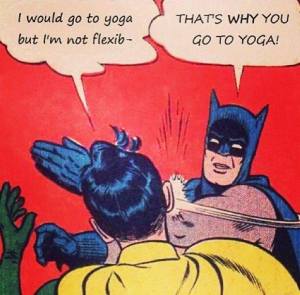Yoga Myth Busters : “I’m Not Flexible Enough To Do Yoga”
If I had received a secret yoga power for every time I’ve heard that statement, I’d be enlightened by now. As yoga teachers, we shake our heads in frustration when we hear it, because that’s as illogical as saying I’m too dirty to take a shower. It’s precisely because you’re inflexible that you need yoga.
 Can’t touch your toes? Perfect! You’re an ideal candidate for yoga. If anything, you could benefit even more from yoga than the naturally flexible yogis, whose bones and joints genetically slot into place with minimal effort. Your stiffness means you’ll really feel the positive effects as your body starts to experience relief from being tight.
Can’t touch your toes? Perfect! You’re an ideal candidate for yoga. If anything, you could benefit even more from yoga than the naturally flexible yogis, whose bones and joints genetically slot into place with minimal effort. Your stiffness means you’ll really feel the positive effects as your body starts to experience relief from being tight.
Ultra-bendy yogis can also easily injure themselves through hyperextending their joints, or going too deeply into a pose. Lucky you, Mr or Ms Creaky Joints—the more inflexible you are, the quicker and louder your inner alarm will ring when you’re reaching your limits, and so you’ll stop (if your ego is in check) and avoid injury.
Yoga isn’t about an end goal that culminates in a glamorous photo of an impossible pretzel pose, anyway. If we did manage to tuck one foot behind the head, does that make us a better person? Of course not.
What does make us feel better, is releasing tension in the body, easing the mind from the busyness of the day, and taking long, relaxing breaths.
Ready to take your rigid limbs to the mat, then? Good. Some tips along the way:
- Patience. Cultivate buckets of it. Without patience, you may force yourself too far into a pose, and cause injury.
- Experiment and find a yoga class where you fit in, with an experienced and encouraging teacher who understands your body type.
- Don’t give up after one or two classes. I’m naturally inflexible and I promise you, with regular practice, it does get easier—to the point that it can become seductively addictive, because you feel so good during and after yoga.
- Explore. Be curious, instead of judgmental, about the physical mechanics of your body and how and when it feels challenged. What happens if you relax a bit in the poses, instead of trying so hard? Are you holding your breath instead of breathing with ease?
- Warm up before yoga, especially if the weather is cold. Try a short walk, or arrive ten minutes early to do some simple stretches.
- Avoid comparing and competing—with yourself as well as with others. It doesn’t matter what’s happening on the mat next to you. As long as you’re in the zone of safe alignment, measured breathing, and no pain, you will benefit from your practice.
 Go for it! Get your stiff and inflexible bod over to a yoga studio, recognize and smile at the other kindred spirits who can also hardly touch their knees, let alone their toes, and ease into some stretches that will make your muscles, joints and soul sigh with gratitude.
Go for it! Get your stiff and inflexible bod over to a yoga studio, recognize and smile at the other kindred spirits who can also hardly touch their knees, let alone their toes, and ease into some stretches that will make your muscles, joints and soul sigh with gratitude.
[as published in Today’s Yoga Magazine]


